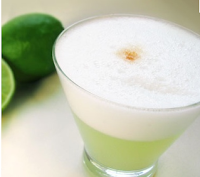 So what did we find out? We did in fact prove that copper makes better egg white foam in a Pisco Sour...when you make it without the lime. We also find out that contrary to what we had read, Lime doesn't help , in fact just the opposite.
So what did we find out? We did in fact prove that copper makes better egg white foam in a Pisco Sour...when you make it without the lime. We also find out that contrary to what we had read, Lime doesn't help , in fact just the opposite. Here's the process we used...the recipe was of 2 ounces of Pisco Porton (from my private stash handcrafted by the inimitable Johnny Schuler), 1 ounce of fresh-squeezed lime juice, 1 ounce of simple syrup (1:1 concentration) and three drops of bitters on the foam.
Method 1 was a steel one-piece shaker loaded with a handful of copper plumbing fixtures.
Method 2 was the same recipe using a traditional Boston Shaker.
(For one set of the tests we also tried whisking the mixture in a copper bowl which just made a big mess.)
Results...disappointingly, they were very comparable in terms of amount of foam and stability (I can't tell you how long it lasted because we drank the samples...hey, I'm just saying!)
Then we decided to isolate one of the variables. So we did it a couple of times with the same two methods but without the lime and found that we ended up with much better foaming properties for the copper fitting method...we could even create little peaks in the foam.
 |
| Better foam with the copper, but without the lime. |
 | |
| You can see the difference in texture with the copper. |
OK, so using copper fittings isn't necessarily a commercial solution, but Fred Yarm suggested we try copper scrubbing pads, which we'll do tomorrow...more surface area in contact with the egg, less fracturing of the ice which led to somewhat watered down drinks. then I'm going to go on the hunt for a copper lined shaker...anyone know of a source? Sphere: Related Content





